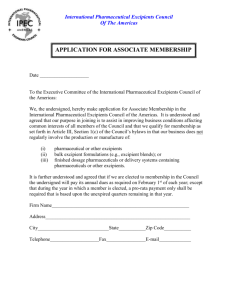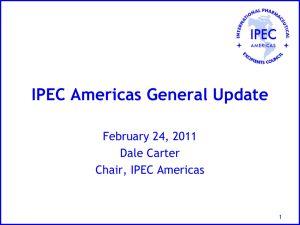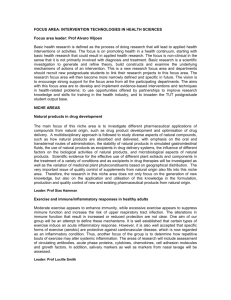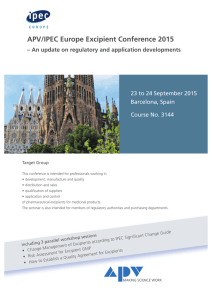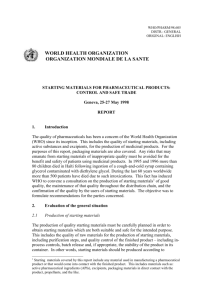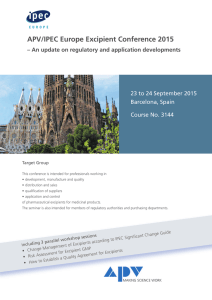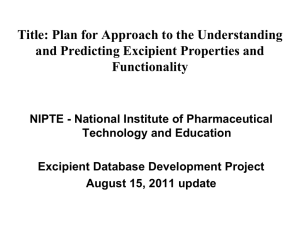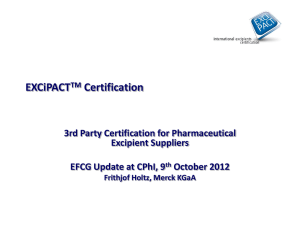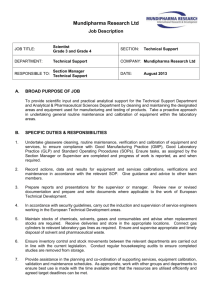Sessions 1 & 2
advertisement
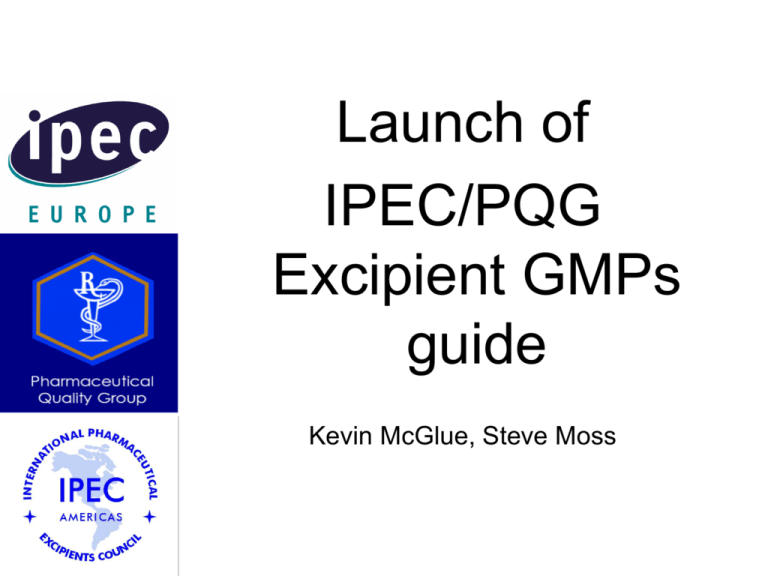
Launch of IPEC/PQG Excipient GMPs guide Kevin McGlue, Steve Moss IPEC/PQG Excipient GMPs guide • • • • • • • • The organisations Background Key milestones Joint charter (governance and oversight) Development process Major improvements Benefits to Industry and Regulators Implementation Strategy IPEC • International Pharmaceutical Excipients Council • Formed in 1991 by manufacturers and endusers of excipients • Three associations covering the US, Europe and Japan • Objective: to contribute to the development and harmonisation of international excipient standards, the introduction of useful new excipients to the marketplace and the development of good manufacturing practice for excipients. • First published GMP Guide for Bulk Pharmaceutical Excipients in 1995, revised in 2001 to align with ISO 9001:2000. PQG • Institute of Quality Assurance, Pharmaceutical Quality Group • Formed in UK in1977 • Key objective: To promote the development of a consistent approach to pharmaceutical quality and good manufacturing practice. • In 1990 published three codes of practice pharmaceutical raw materials, printed and contact packaging materials. In 1995 revised and integrated these with ISO 9002:1994. • Raw materials code revised and reissued as PS 9100:2002 Pharmaceutical excipients, an application standard and GMP guide for pharmaceutical excipients. Background to the joint guide • Increased focus on Excipient GMPs led to the need for a single international guide • June 2002 – IPEC Europe, IPEC Americas and PQG signed a letter of intent in committing to collaborate on a Baseline GMP guide for excipients • December 2002 – Joint charter issued Joint Charter – Purpose • To produce a joint international GMP guide for excipients, which will build upon and replace the two groups’ existing documents. It will be aligned to ISO 9001:2000 and include a baseline (minimum) GMP for excipients. • During development of the document excipients used in more critical applications will be considered for inclusion in Appendices, as appropriate • The document will also provide the basis for a certification scheme for excipient suppliers separate from the basic GMP guideline. Joint Charter - Boundaries • Includes: – GMP guide for excipients for all pharmaceutical products – GMP guide could be used for certification in subsequent phase – Future inclusions include audit and training guides • Excludes: – – – – Sterile excipients Active Pharmaceutical Ingredients Products of biotechnology Certification process Joint Charter - Structure • Steering Committee (Sponsors): – 2 Members IPEC-Europe – 2 Members IPEC-Americas – 2 Members PQG • Team Members (Core team): – Six members, two from each organisation Joint Charter – Some Stakeholders 1 • • • • • • • • • • Association of the British Pharmaceutical Industry, CEFIC, Certification bodies for PQG Scheme, European Federation of Pharmaceutical Industry Associations, Excipient suppliers, European Community DG3, European Pharmacopoeia, International Conference on Harmonisation, IPEC-Europe, IPEC-Americas, International Pharmaceutical Excipients Auditing Inc (IPEA), Joint Charter – Some Stakeholders 2 • • • • • • • • Institute of Quality Assurance PQG committee, Pharmaceutical companies, Pharmaceutical Research and Manufacturers of America (PhRMA), Regulatory bodies (Food & Drug Administration, Medicines & Healthcare Products Regulatory Authority etc), United States Pharmacopoeia, World Health Organisation, Japanese Pharmaceutical Excipients Council (JPEC) as an observer Key milestones • • • • • • Initial meeting Review process Draft new guide Consultations and review Final review Publication and launch Initial team meeting 23rd January 2003 • • • • • Key principles Project timescales ISO 9001 format Overall document structure Consultation and review process Initial review process Started March 2003 • Reviewed detail of key source documents – PQG, IPEC, ISO 9001, ICH Q7a • Compared all the clauses in a matrix • Chose the most appropriate guidance appropriate for excipients • Resolved differences • Significant update in line with current thinking • Involved careful consideration and deliberation Drafted NEW guide Q2 2003 to Q1 2004 • Improved assignment to ISO sections – more logical flow and improved readability • Key areas improved with significant rewriting include: – structure & responsibility of quality unit, product release, validation, stability, change control, GMP principles, auditing considerations • “Continuous processing” accounted for throughout – E.g. bulk materials, batch documentation and release Further development of guide Q2 to Q3 2004 • Many multi-day meetings in UK, US, France • Continual adaptation to the prevailing changing environment • Maintained focus on developing voluntary baseline guidance – Potentially with need for additional guidance for specialist applications Consultation and review Q4 2004 to Q3 2005 1. Members comment x2 (some external bodies eg EFPIA via members) – Consolidated comments (100’s!) to produce approved draft for external release 2. External circulation - Key organisations including regulatory authorities, trade organisations and other stakeholders – Consolidated comments 3. Issued to members for final comment – Consolidated comments to produce final draft 4. Comprehensive QC checks x2 teams – Corrected to produce draft for printing Publication & printing Q4 2005 Hardcopy • US English by IPEC Americas – letter and pocket versions • UK English by IPEC Europe – A4 and pocket versions Electronic • A4/letter downloadable from websites Thanks to the GMP/Partners groups and the wider membership of each organisation for help and excellent contributions! Major improvements 1 • Better assignment to ISO sections to give more logical flow and improved readability • Accurate and legible wording • Appropriate guidance for excipients • Key ‘awkward clauses’ addressed e.g. stability, validation, change control • Included continuous processing particularly the impact on batch definition and records Major improvements 2 • Improved auditing considerations - GMP principles and applications • Harmonized glossary - rationalised to ICH where possible • Consistent use of terminology e.g. document, records; rework, reprocess • Removed ambiguity for international use (e.g. recall/retrieval; batch/lot) Benefits to Industry and Regulators 1. Broad acceptance • Document critically reviewed by all stakeholders to obtain consensus • Well received by excipients industry and by pharmaceutical companies and their industry bodies, regulators EMEA and EC - suggests balance is appropriate • Overall good collaboration between US and Europe resulting in international acceptance Benefits to Industry and Regulators 1. Broad acceptance (cont’d) • Participation and involvement with many good comments from many members, organisations, etc • Working with EC - new guide helping focus discussions and benchmarking appropriate principles which may become law for certain excipients Benefits to Industry and Regulators 2. Ease of application • Builds additional GMP guidance onto the ISO framework – commonly used by the industry already • Practical guidance for excipient manufacturer – balancing pharmaceutical customers' expectations with usual constraints • Clear unambiguous wording Benefits to Industry and Regulators 2. Ease of application (cont’d) • Provides common guide eliminating the need for multiple customers' requirements. – Manufacturer – applies common & appropriate standard, quality systems & controls – User – provides common expectation of what is appropriate for excipient manufacturers, audits • Clearly differentiates guidance for excipients – more than ISO 9001 – more appropriate than ICH Q7a Implementation Strategy • Launch events – IPEC Americas – Orlando, 26th January 2006 – PQG – London, 7th February 2006 – IPEC Europe – Cannes, 9th February 2006 Additional copies available now • ipec.org and pqg.org – Order forms for printed copies – Members download free • Please spread the word!


